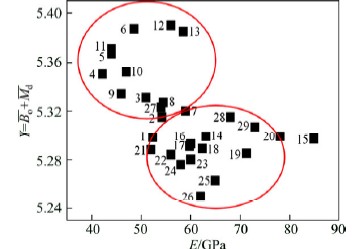Abstract: A new kind of β biomedical titanium alloy, Ti−35Nb−4Sn−6Mo−9Zr, composed of non-toxic elements Nb, Mo, Zr and Sn with lower elastic modulus and higher strength was designed based on d-electron alloy design theory and JMatPro software using orthogonal experiment. The microstructure and basic mechanical properties of designed alloy were investigated. The results show that the alloy is composed of single β equiaxed grains after solution treatment at 800 °C. Compared with Ti−6Al−4V, the mechanical properties of the designed alloy are more excellent: E=65 GPa, σb=834 MPa, σ0.2=802 MPa, and δ=11%, which is expected to become a promising new type implanted material. The research approach adopted can reduce the experimental time and cost effectively, and get the ideal experimental results.
1 Introduction
As a biomedical metal material used for load-carrying implant, titanium alloy has got extensive applications because of its good biocompatibility, mechanical properties and corrosion resistance in the body fluid environment. Recently, β titanium alloy becomes one of the hottest topics in the field of biomedical titanium alloys for its lower elastic modulus compared with α+β titanium alloys [1−3].
For a multi-component titanium alloy, it is difficult to define the relationship of properties−microstructures−ingredients [4,5] because it often involves the complicated interactions between the elements and the microstructures. The design methods on biomedical titanium alloys mainly include delectron alloy design theory and those based on vague logic and neural network technology at present [6−9]. Reports [6,7] show that Ti−29Nb−13Ta−4.6Zr alloy with low elastic modulus was designed successfully using d-electron alloy design theory. The elastic modulus of the alloy is lower (63 GPa); however, its strength is lower too (σb=590 MPa, σ0.2=520 MPa) compared with Ti−6Al−4V (σb=895 MPa, σ0.2=825 MPa) which is widely used on clinic at present. So far, there is no such theory which can design a kind of biomedical titanium alloy having lower elastic modulus and higher strength at the same time. JMatPro software developed by the British Thermotech company is a kind of simulation software which can calculate the strength of metal materials. The strength simulation on titanium alloys using JMatPro software is now focused on Ti−Al system and satisfactory results are achieved [10,11].
Based on the d-electron alloy design theory and JMatPro software, a biomedical titanium alloy Ti−35Nb−4Sn−6Mo−9Zr with lower elastic modulus and higher strength is designed, and its mechanical properties are verified.
``````
